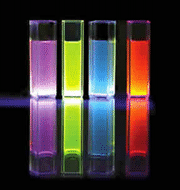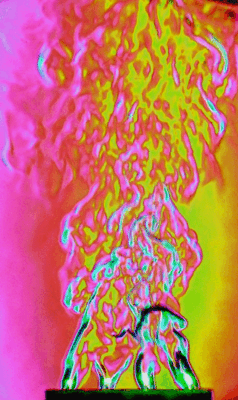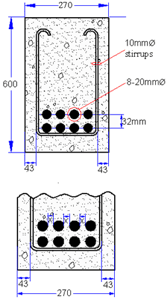

I have always been interested in science and technology. At secondary school I built a tuneable liquid organic-dye laser (suitable dyes are pictured on the left) and developed a system for projecting and photographing full-colour Schlieren images (false-colour pictures of density variations in a transparent medium) such as the one on the right showing heat rising from four candles.
I intended to study applied physics and electronics at Durham University but during the first term I used computers extensively and decided that computer science was more interesting. In 1975..77 an honours computing degree was not available at Durham University, but a General Science degree offered maximum exposure to computing and also allowed the study of many other scientific disciplines.
During university vacations I gained valuable work experience at Varian Data Machines (now part of Unisys), working on development of the MP/3 operating system and its compilers.
Job
On leaving Durham with a BSc in General Science, I obtained a job with PMA Ltd., a software development company in Horley, Surrey. The job involed telemetry and real-time computer systems.
 My first project was the design of a system for real-time monitoring and control of water for the Qatar Water Authority. This involved detailed system analysis, data structure design, and programming specialist devices for monitoring water levels and flows in reservoirs and water towers. Other functions included raising alarms and controlling valves and pumps. There were several trips to the Middle East. The hardware was DEC PDP/11, software: RSX11M, and RTL/2.
My first project was the design of a system for real-time monitoring and control of water for the Qatar Water Authority. This involved detailed system analysis, data structure design, and programming specialist devices for monitoring water levels and flows in reservoirs and water towers. Other functions included raising alarms and controlling valves and pumps. There were several trips to the Middle East. The hardware was DEC PDP/11, software: RSX11M, and RTL/2.
The second part required more trips to Qatar, this time as trouble-shooter for a previous project, monitoring and controlling electrical switch gear on the Qatar national grid. Again, PDP/11’s but Fortran and assembly language.
Euro Computer Systems
 After two years with PMA and extended periods in the Middle East I was invited onto the board of Euro Computer Systems Limited, a software consultancy in Redhill, Surrey. As technical director I helped develop techniques for porting sophisticated mini-computer software onto small (< 64k RAM!) personal computers running under CP/M.
After two years with PMA and extended periods in the Middle East I was invited onto the board of Euro Computer Systems Limited, a software consultancy in Redhill, Surrey. As technical director I helped develop techniques for porting sophisticated mini-computer software onto small (< 64k RAM!) personal computers running under CP/M.
Notable successes were the BARD reinforcement scheduling and detailing system for the Cement and Concrete Association, and FORPA a government-funded program for adjusting prices of building contracts allowing for indices of inflation, for the Computers in Construction Association (CICA).